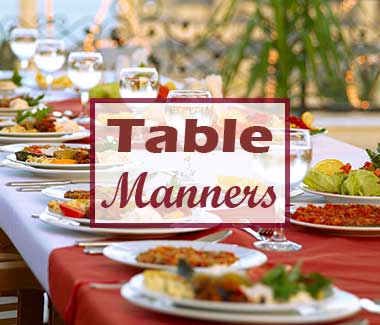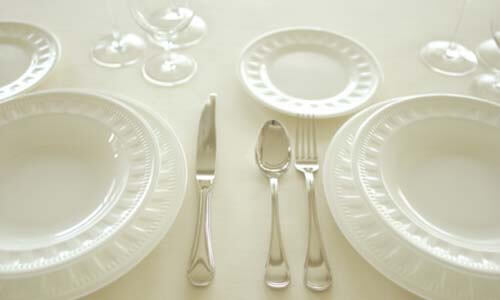Knives
Table Setting Guide
Knives are made in a host of shapes, some with serrated blades, others with dull edges and pointed or rounded tips.
- Knives with serrated blades, such as steak knives, cut meat.
- Knives with dull blades, such as dinner knives, luncheon knives, and dessert knives, cut soft or cooked food.
- Knives with pointed tips, such as a steak knives, fruit knives, and fish knives, carve meat, pare fruit, and separate fish bones.
- Knives with blunt ends, such as butter spreaders, spread food.
Table knives are made in seven sizes, including, from large to small:
- Dinner Knife;
- Steak Knife;
- Luncheon Knife;
- Fish Knife;
- Dessert Knife;
- Fruit Knife; and
- Butter Spreader.
The dimensions of knives below may vary slightly according to the manufacturer.
Dinner Knife
The dinner knife is the longest knife in a set of flatware.
It is used to cut and push food and is laid on the table at all meals, formal and informal. The exception is when soup is served as the main course, and a dinner knife is not required.
The dinner knife is made in two sizes: place size and continental size.
- The place size measures around 9¼ inches in length.
- The continental size is about 9¾ inches long.
When a knife is needed to cut an extra-large salad leaf, such as a piece of romaine or a thick wedge of lettuce, a dinner knife is used. The exception is at a formal dinner when an extra dinner knife is provided for salad.
Steak Knife
The steak knife is a specialized knife not made as part of a set of flatware.
- It is approximately 8¼ to 9 inches long and has a sharp tip and a serrated edge to cut thick portions of meat.
- At a formal meal, a steak knife is not provided if meat is served roasted, which is easily cut with a regular dinner knife.
Luncheon Knife
The luncheon knife is 8 to 8¾ inches long, a size that balances the proportions of the luncheon plate, which is 8½ inches in diameter.
Although the luncheon knife is used at formal and informal luncheons, it is not mandatory for either occasion. Today, luncheon knives are not commonly used and the dinner knife is normally used at the midday meal.
Fish Knife
Fish knives vary in size but usually measure about 8¾ inches long.
- The fish knife is a specialized shape not included as part of a flatware set.
- The fish knife features a wide blade with a dull edge and a tip made with a notched point used to separate the skeleton from the body and lift the bones onto a plate.
- They are used in both formal and informal dining.
Dessert Knife
The dessert knife measures approximately 8 inches long and features a narrow blade and a rounded or pointed tip. The rounded tip is used to section soft desserts, and the pointed tip to cut hard desserts.
The dessert knife is a specialized utensil not made as part of a flatware set. It is used in formal and informal dining with a dessert fork.
Fruit Knife
The fruit knife is used to cut and peel fresh fruit at the table in formal and informal dining.
The fruit knife is approximately 6½ inches to 7¼ inches long.
It is a specialized utensil not made as part of a flatware set.
The fruit knife features a pointed tip and a narrow blade that is straight or slightly curved.
Sometimes the edge of the blade is serrated.
Butter Spreader
The butter spreader is approximately 5 to 6 inches long. It is the smallest knife in a set of flatware.
The tip of the blade is rounded and some are slightly wider at the tip.
The butter spreader is used differently in formal and informal dining.
- At a formal dinner given in a private home where strict protocol is followed, the multiplicity of courses provides sufficient taste and texture without the need for bread and butter, and a butter spreader is not used.
- However, at formal luncheons and informal meals, fewer courses are served, bread and butter are provided, and a butter spreader is used.



